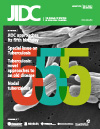Nodal tuberculosis revisited: a review
DOI:
https://doi.org/10.3855/jidc.2090Keywords:
Mycobacterium tuberculosis, lymphadenitis, pathogenesis, diagnosis, fine needle aspiration cytologyAbstract
Lymphadenitis is the most common extrapulmonary manifestation of tuberculosis. Tuberculous lymphadenitis is considered to be the local manifestation of the systemic disease, whereas lymphadenitis due to nontuberculous mycobacteria is truly a localized disease. A high index of suspicion is needed for the diagnosis of tuberculous lymphadenitis which is known to mimic a number of pathological conditions. Over the last two to three decades, fine needle aspiration cytology (FNAC) has emerged as a simple out-patient diagnostic procedure for the evaluation of tuberculous lymphadenitis and has replaced lymph node biopsy for histopathology. A number of molecular methods have also been introduced in diagnostics which have greatly improved the diagnostic accuracy. This article provides a review of epidemiology, clinical manifestations, and pathogenesis and emphasizes current trends in pathologic diagnosis of nodal tuberculosis.Downloads
Published
2011-12-09
How to Cite
1.
Handa U, Mundi I, Mohan S (2011) Nodal tuberculosis revisited: a review. J Infect Dev Ctries 6:6–12. doi: 10.3855/jidc.2090
Issue
Section
Reviews
License
Authors who publish with this journal agree to the following terms:
- Authors retain copyright and grant the journal right of first publication with the work simultaneously licensed under a Creative Commons Attribution License that allows others to share the work with an acknowledgement of the work's authorship and initial publication in this journal.
- Authors are able to enter into separate, additional contractual arrangements for the non-exclusive distribution of the journal's published version of the work (e.g., post it to an institutional repository or publish it in a book), with an acknowledgement of its initial publication in this journal.
- Authors are permitted and encouraged to post their work online (e.g., in institutional repositories or on their website) prior to and during the submission process, as it can lead to productive exchanges, as well as earlier and greater citation of published work (See The Effect of Open Access).








